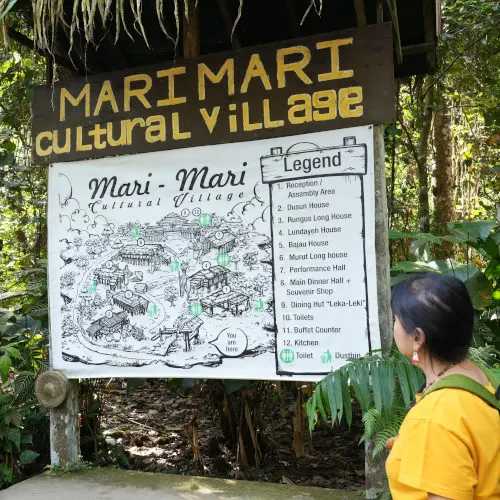
Here is our story at Mari Mari Cultural Village.
After two days of physically demanding mountain climbing at Mount Kinabalu, we took a day off to unwind and explore Kota Kinabalu. During our visit, Mari Mari Cultural Village was one of the most important sites we visited.
The Mari Mari Cultural Village is a non-profit organization established in 1996 to preserve and share the ethnic culture of Borneo. The village showcases the customs and traditions of different in Borneo. Our tour operator, Horizon Borneo, had arranged for an English-speaking guide to provide an in-depth explanation during the tour.
Arrived at Mari Mari Cultural Village
Upon meeting our knowledgeable in-house guide, born and raised in Borneo, we were eager to delve into the fascinating culture of the region's various tribes at the Mari Mari Cultural Village. Our guide's expertise gave us an in-depth understanding of the traditions of Borneo's ancestors.
Excitement coursed through us as we anticipated discovering more about the daily lives and customs of Borneo's primary ethnic groups: the Dusun, Lundayeh, Murut, and Bajau.

As we approached the Mari Mari Cultural Village, the staff donning traditional attire greeted us at the vast parking area with a customary welcome ceremony. We couldn't resist taking pictures in front of the signboard before entering the village.
The entrance to the village featured various traditional symbols and artifacts that reflected the spiritual beliefs of the different ethnic groups in Borneo. After a brief introduction by our guide, we traversed a suspension bridge that connected us to the distinct houses of each tribe.
Don't miss the video we shot at Mari Mari Cultural Village. It is at the end of this article. 👇👇
1. Dusun House

Upon crossing the bridge, we arrived at the Dusun house, where our guide informed us that the Dusun tribe comprises several sub-tribes that share the same language and are the largest tribe in Sabah.
Our guide then led us to a raised structure known as the tangkob, a rice storage hut used by the family. The removable ladder-equipped structure serves two purposes: to safeguard unprocessed rice from animals and protect it from occasional flooding by keeping it dry.
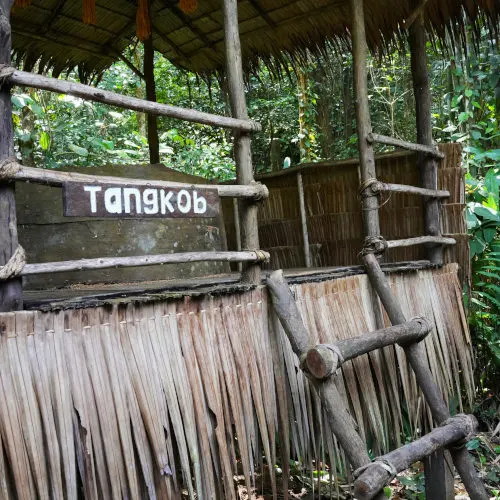
One notable feature of the Dusun's House is their fondness for wine, which is reflected in the display of wine urns within their homes.
Since the Dusun house is made primarily of bamboo tree, the kitchen is in an open area for safety reasons, and food is prepared using the ancient tribal smoking method.

The ladder and some furniture were crafted from kayu berlian, a type of wood found exclusively in Borneo.
The Dusun tribe also demonstrated how to make their traditional rice wine called Lihing, and we had the rice-wine tasting.
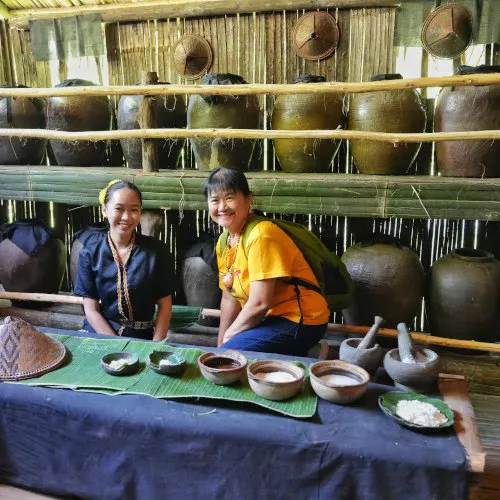
They also showed us how to make another alcoholic drink called Montoku.

They also showed us the traditional bamboo cooking method called linapak by the Dusun tribe, which included ingredients such as chicken, potatoes, onion, red chilies, and salt.

Related article: We climb Mount Kinabalu while in Sabah. Read the story of our climb here.
2. Rungus Long House

The Rungus tribe, the fourth largest in Sabah after Murut, Bajau, and Kadazandusun, takes its name from Tomborungus, the son of Aki Ragang, who lived at the top of Mount Kinabalu. During our visit to the Rungus house, we were offered a taste of their specialty, madu kelulut, which is stingless bee honey.
Our guide also showed us their musical instrument, kulintangan.

And the traditional fire-making method.
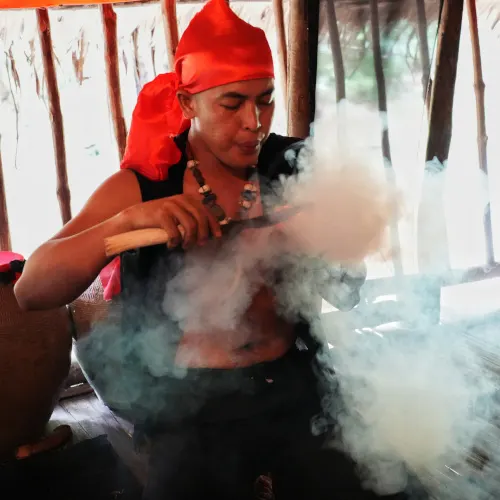
3. Ludayeh House

Our next stop was the Lundayeh tribe's house, also known as Lun Bawang, located at the southwestern corner where Sabah meets Sarawak and Borneo Kalimantan, in the Ulu Padas area.
As we approached the house, we saw a totemic crocodile-shaped monument outside. The Lundayeh people have a long-standing tradition of commemorating their ancient heroes' prowess through ceremonial dances around a monument shaped like a crocodile crafted from clay. The crocodile is considered a symbol of power and the vanquished foe, and the tradition originates from a hero who decapitated his adversary triumphantly.
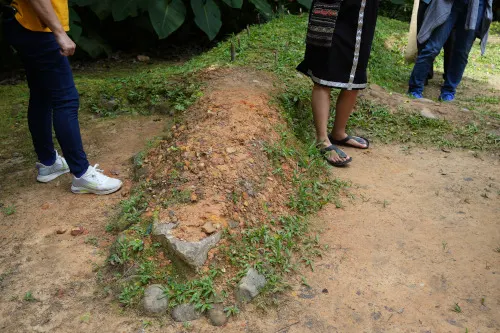
We learned about Lundayeh's traditional skills and daily activities inside the house. We were fascinated by how they used tree barks to create clothing and baskets.
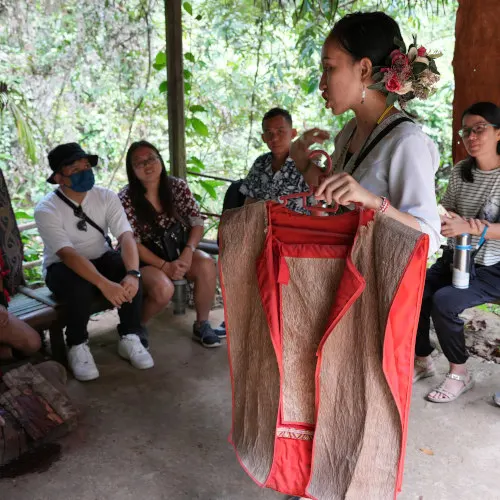
4. Murut House
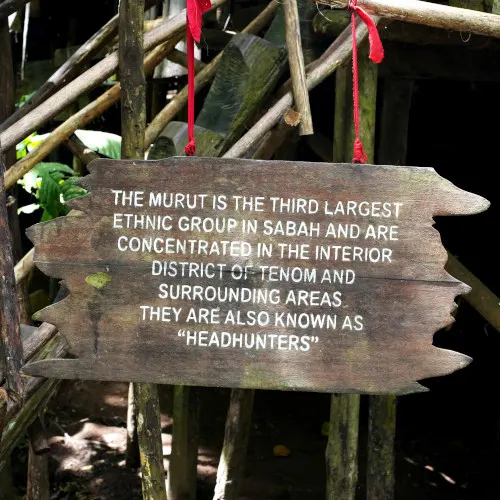
Our next stop was the traditional Murut longhouses. The Murut tribe is known for their bravery in warfare that struck fear into their enemies. During our visit, our guide shared the Murut people's traditional form of entertainment, known as "Lansaran."
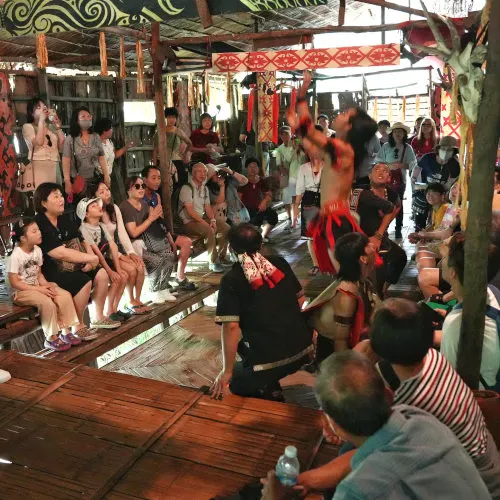
This involves dancing on wooden platforms constructed on bamboo springs, which serve as a traditional trampoline-like floor in their longhouses. This unique activity is often performed during celebrations and resembles a trampoline in its movements.
5. Bajau House
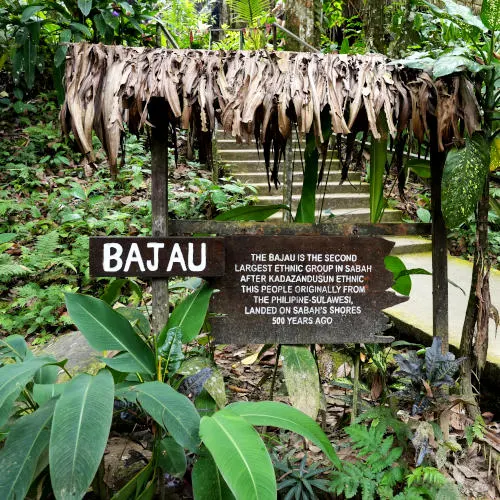
Our last destination was the Bajau tribe house, specifically the land Bajau. It is important to note that there are two types of Bajau, namely the Bajau Laut or sea gypsies, who build their homes on stilts over the water.

One of the ladies in the house demonstrated how to prepare kuih jala from scratch, and we had the opportunity to taste it. The Bajau tribe is relatively affluent, evidenced by their vibrant decorations and well-furnished homes.

We were also treated to some traditional delicacies like penjaram, which the ladies in the kitchen had made.

Cultural dance performance

We visited the Mari Mari Cultural Village, where the highlight of our visit was the cultural performance.

The performance showcased the traditional dance performances of the various tribes, and the dancers were dressed in colorful costumes. Their movements were rhythmic and mesmerizing, leaving us in awe.

At the end of the performance, we were invited to participate in the dance with them. Lunch at the restaurant

After the cultural performance, we were taken to the dining hall for a buffet lunch. We were excited to taste Sabahan delicacies and were not disappointed.
A place you should visit
Our trip to the Mari Mari Cultural Village has given us an in-depth look at Borneo's cultural heritage and tradition. Here, visitors can witness distinctive houses, costumes, and traditional skills of five major ethnic groups: the Dusun and Rungus farmers and traders, the Lundayeh hunters and fishermen, the Bajau cowboys and sea gypsies, and the famously feared warrior tribe, Murut. You can experience, see, hear, taste, and feel the uniqueness of Sabah by visiting this village. It is like a living museum to learn about the diversity and beauty of Borneo's ethnic cultures. The entrance fee to the Village is RM100 for adults and RM90, subject to changes. There are two sessions available, 10 am and 2 pm daily.
Watch our video shot during our trip at Mari Mari Cultural Village 👇👇
If you have read this blog post this far, don't miss out on the video shot during our trip to Mari Mari Cultural Village. Click the image below to watch on YouTube (shot in high definition!).

